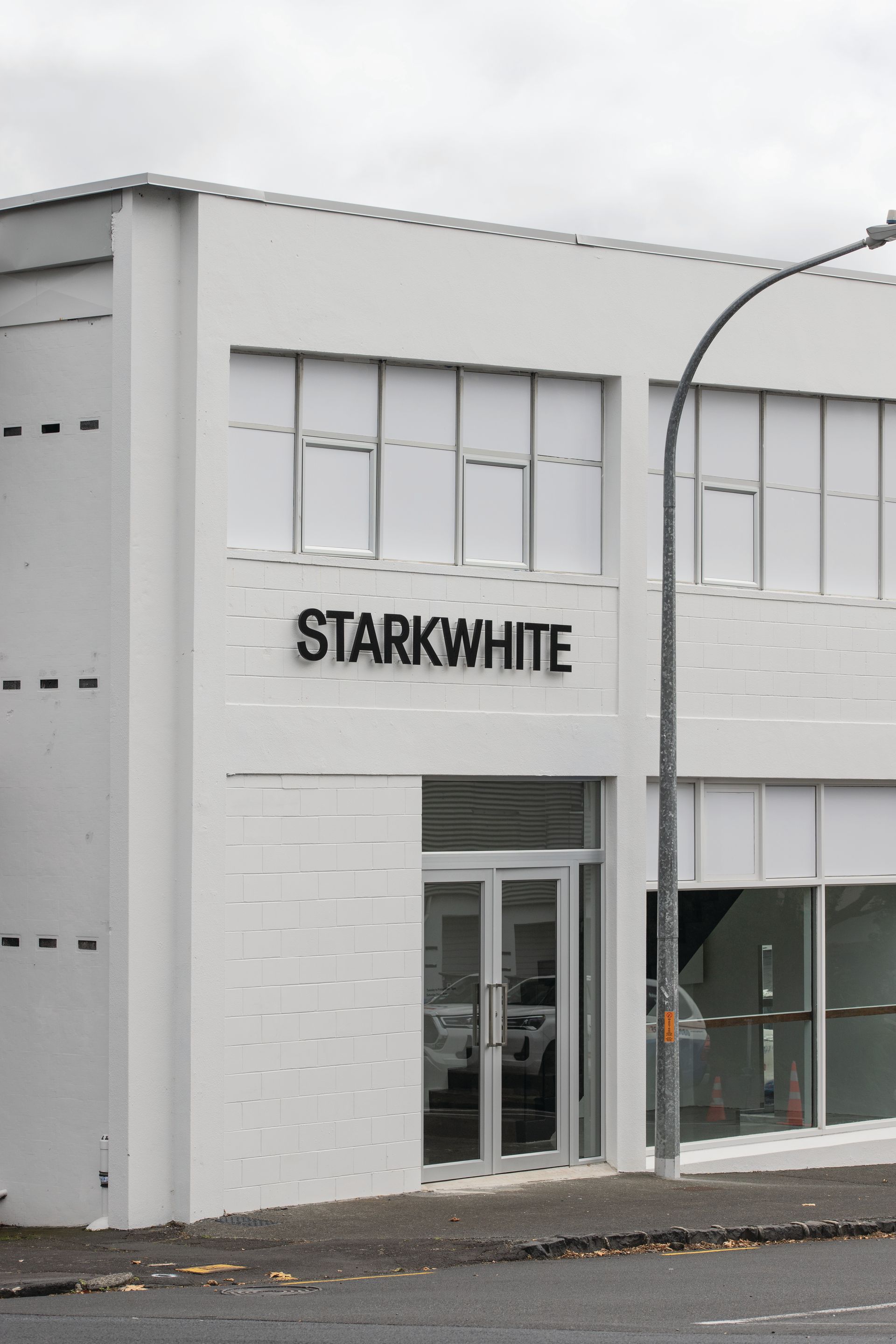Starkwhite
Words: Suzanne McNamara
Photography: Blink Ltd
You could have been forgiven for not noticing the nondescript building at 94 Newton Road before dealer gallery Starkwhite moved in. The recent makeover has made the building expansive and open, with its coat of bright white paint. At road level, you can see contemporary art basking on the white walls of the three-storey gallery that houses and deals in some of Aotearoa New Zealand’s most prestigious artists.
Dominic Feuchs is Starkwhite’s director and a founder alongside former and now retired business partner John McCormack. Dominic and his team sit in the middle of the ground floor. His chair faces the front door, ready to welcome people into the gallery to share his enthusiasm and love of art.
Dominic is open and friendly. He shuns the art world's reputation of being inaccessible and pretentious and he has set about making Starkwhite the opposite. He says everyone appreciates and reacts to art in their own way, from the person who studies art to the one who buys it.
“That's why it's always interesting seeing how kids react to art. They get really excited by it. They just experience it at a very honest level.”
Dominic’s role is the relationship-builder and he sees Starkwhite as the interface between the artists and the person viewing their work.
“So we try to be as accessible and as engaged as we can because we effectively are offering a visual art shop.”
And he says we have a healthy art scene in New Zealand. “It has changed dramatically, but I think New Zealand has always had a strong culture, certainly in the 60s and 70s. In visual art, we have a very sophisticated and well-informed international appreciation, laid by our wonderful Māori art foundations.”
Starkwhite has an impressive stable of artists with whom they work exclusively, including acclaimed New Zealand photographer Fiona Pardington (Ngāi Tahu, Kāti Māmoe and Ngāti Kahungunu), Jonny Niesche (Australia) and Michael Zavros (Greek Australian).
The gallery is anticipating Fiona Pardington’s show when we visit. Dominic explains there’s a pent-up demand for her work, which is selling for “crazy money” on the secondary market. He expects the show to fill all three floors of the gallery.
He’s a huge fan of Fiona Pardington’s body of work and says it sucks you in with a beautiful image and you don’t necessarily need to go to the deeper aspects of understanding what is behind the artwork.
“When you talk to Fiona about the level of research and thought that goes into those works – her mind is phenomenal. The meaning is crystallised in those artworks, which certainly does add to them, but first people are drawn in by these visually beautiful works.”
The exhibition explores her strong interest in New Zealand museum collections and Dominic says for this show she has been working with South Canterbury Museum “photographing the nefarious and strange elements within the objects in there”.
For an artist starting out on their career, Dominic advises it’s about consistent quality and this, he says, is determined by the audience. Fiona is an example of a senior New Zealand artist who has been working for 40 years.
“Anyone can make a couple of good artworks in their life if they turn their mind to it, but to have a 40-year career of constantly making great things and changing things, it’s nigh on impossible.”
Starkwhite’s artist stable includes Billy Apple and Gordon Walters, both artists who are no longer living but were both at the front end of culture during their careers.
“Gordon Walters is one of our great masters, his work does stack up from an art historical point of view of what he was doing through the 50s and 60s. It was mirrored in the major movements overseas while he was adding his own kind of wonderful New Zealand twist to it. And certainly, history has shown that.”
Picking the next art star is not something that Starkwhite participates in because of Dominic’s need for consistent quality. However, they have started working with young Māori artist Jamie Te Heuheu (Ngāti Tūwharetoa). This connection came about through a meeting with mutual friends, when Dominic gave Jamie some art career advice and it grew from there.
The relationship is something different for Starkwhite, because Jamie is in his early twenties and not long out of Elam art school. Dominic was impressed that he was involved in his own artist-run space that showed at the Aotearoa Art Fair in Auckland, while also being devoted to his practice. Starkwhite’s first Jamie Te Heuheu show of paintings was a great success.
Dominic says it has been an easy fit for the gallery. “Jamie is making minimalist paintings, but with a very strong acknowledgment of his cultural background, as well as his Māori background. He's an incredibly hard-working, focused guy and a great painter.”
Dominic explains that indigenous art has always been important, from Peter Robinson right back to Ralph Hotere. “It has always been a significant part of New Zealand art. I think Māori have been hugely valued in the arts and have created an incredible background for New Zealand. And it makes us truly unique.”
Starkwhite’s business is in growth mode, with a gallery in Queenstown doing a steady tourist trade and a Starkwhite gallery in Melbourne, where they manage an Australian stable of artists.
Dominic has an international approach for the gallery’s Kiwi and Australian artists because of the limited pool of art collectors here. But it’s equally about taking local artists to the world as it is about bringing international artists into New Zealand.
Art fairs have exploded globally during the past 10 years and have become an important part of the business. To invest the amount required to attend art fairs, Starkwhite has created exclusive dealer relationships with their artists.
Their first art fair was Basel in Switzerland. “It’s a very famous art fair and suddenly you’ve got 60,000 people who are all massively supportive and interested in art, including our artists. It was a realisation first-hand that the international art world is a pretty phenomenal thing and there’s a lot of collectors out there.”
Dominic says Basel is the mothership of art fairs and can take four days to get around. “It is staggering and overwhelming.”
This year alone they have been to art fairs in Singapore and Melbourne. Dominic explains the fairs, even though expensive, are a highlight. “There are so many positives in terms of audience development, meeting both collectors and artists and raising the profile of the gallery – not to mention travelling to great cities.”
Art fairs, he says, are a moving feast. “They can pop up and then disappear. LA becomes hot and everyone wants to go to LA, but Covid wiped out some of the smaller LA fairs.”
Starkwhite will be celebrating 25 years in 2024. Not bad for a guy who describes himself as a hanger-on at art school who progressed to giving casual advice to friends.
Giving art advice is something Dominic generally steers clear of, however, as he prefers to buy what aesthetically pleases him. He is quick to point out that there is no “good or bad art”; a piece might be considered great art but won’t appeal to him, yet “that doesn’t make it bad art”.
On well-known artists such as Billy Apple, Gordon Walters and Colin McCahon, he says “their work just gets better and better, but there have been times when they've been very fashionable or very unfashionable. It's tough to measure what everyone likes, because it does change so quickly”. His key piece of advice is to “simply buy what you like”.

Starkwhite

